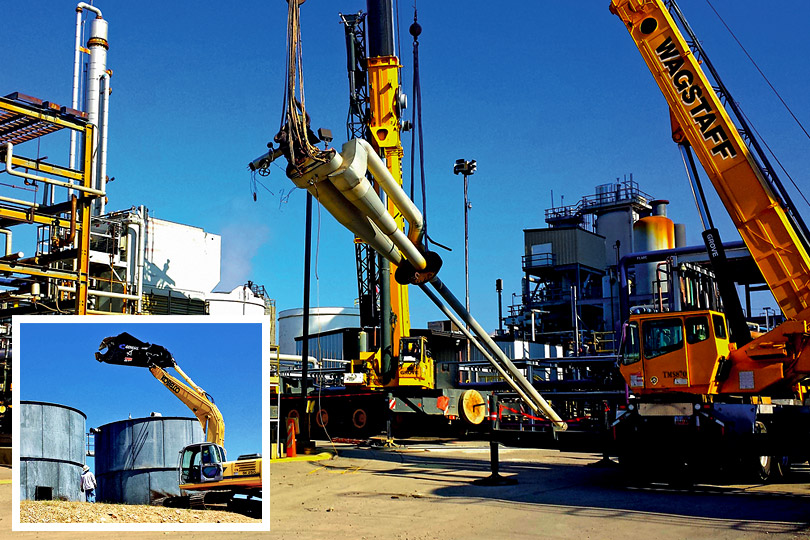The global oil markets have seen much turbulence of late, with oil prices falling sharply in the second half of 2014, and only slight recovery as of March 2015.

Global Oil Prices See Stark Plunge
This sudden fall in oil prices is due to the confluence of three factors: the shale oil revolution in the US flooding its markets with plentiful supply, global oil demand remaining tepid amidst an uncertain global economic outlook, and the decision of OPEC (Organization of the Petroleum Exporting Countries) in November to maintain oil production levels to protect its market share.
While cheaper oil is a boon for the global economy – lowering the costs of economic production and making goods cheaper in general – the sharp decline in oil prices is sending shockwaves throughout the oil exploration and production value chain, with many oil majors shutting down oil rigs in operation and putting exploration activities on hold. So far, oilfield services providers Baker Hughes, Halliburton and Schlumberger have all announced significant job layoffs in the wake of falling oil prices and declining revenue.
Playing the Long Game
While the current climate is a challenging one, the long term outlook for the oil and gas sector – especially within the Asia-Pacific region – is much more sanguine. Speaking at the International Oil and Gas Industry Conference and Exhibition (OSEA) in December 2014, Singapore’s Second Minister for Trade and Industry Mr S Iswaran pointed out that despite the short-term price volatility, the strong economic fundamentals in Asia-Pacific – together with rapid population growth and economic development – will continue to drive energy demand and thus expenditure on exploration and production.
Indeed, this is a point of view is echoed by ExxonMobil’s Singapore chairman Mr Gan Seow Kee. In an interview with the Business Times, Mr Gan acknowledged the challenges brought about by the US shale revolution and record low oil prices globally, but highlighted the need to take a long-term view. He too pointed to the region’s strong economic growth, and how it has accounted for more than two-thirds of oil demand growth worldwide since 2000.
Singapore’s Offshore and Onshore Sectors
Over the years, oil and gas exploration has moved to deeper waters and harsher environments, to keep up with the growing energy needs of the global economy. This calls for more sophisticated technologies and offshore vessels to cope with the challenges presented by such environments. Singapore’s marine and offshore sector has benefitted greatly from this upturn in exploration and production activity, growing from strength to strength to become a global market leader in the building of jack-up rigs and conversion of Floating Production Storage Offloading (FPSO) units. Roughly 70 per cent of the world’s jack-up rigs used for oil exploration and drilling are produced here.
In the local landscape, the two large shipyards groups Keppel Offshore & Marine and SembCorp Marine stand out as the largest and second largest rig-builders in the world respectively. Over the years, companies in Singapore have managed to build up quality ship repair capabilities as well as know-how in the construction of oil rigs. In 2012, the offshore rig building sector generated a total turnover of S$9,082 million, underlining its importance to the Singapore economy.
Singapore’s status as a regional oil and gas hub has also attracted major oil and gas specialist equipment companies such as Halliburton, Cameron, FMC Technologies, Baker Oil Tools and Schlumberger, who have established their regional headquarters and critical manufacturing lines in Singapore to produce sophisticated components such as drill bits, wellheads, downhole equipment and production equipment.
Besides Singapore’s reputation as an advanced manufacturing hub with a talented and skilled workforce, these multinational companies can also count on a well-established eco-system of supporting industries, offering critical turnkey manufacturing support and ancillary services to global standards. These local enterprises are able to meet the most demanding of specifications and the highest levels of quality control and safety. To offer one-stop support throughout the value chain, the supporting industries offer a myriad of activities ranging from precision engineering, EPC services, special processes, system integrators and equipment/components production.
Peeking Through the Hazy Outlook
With relation to the current environment of record low oil prices, Singapore’s Minister for Trade and Industry Mr Lim Hng Kiang spoke in Parliament in January, saying that prospects for the offshore and marine sector remain stable for the immediate future. However, he also cautioned that the sector could eventually be affected should oil prices continue to stay low for the long term. Investment analysts are generally of the same view too, noting that Keppel and SembCorp shipyards have built up strong order books prior to the decline in oil prices, insulating them somewhat from the worst of the market’s volatility.
Meanwhile, experts from the International Energy Agency (IEA) have said that a reversal in trend for oil prices is possible this year, though may not have bottomed out at the start of the year yet. They note that while price recovery – barring any major disruption – may not be imminent, signs are mounting that the tide will turn and a rebalancing may begin to occur in the second half of the year.